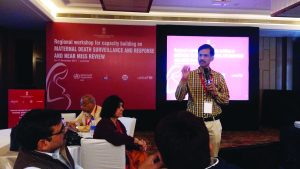Moving from Maternal Death Review to Surveillance and Response
Maternal Death Surveillance and Response (MDSR) is expected to be important to reduce the MMR further and eliminating preventable maternal mortality. MDSR is a form of continuous surveillance that links the health information system and quality improvement processes from local to national levels, which includes the routine identification, notification, quantification and determination of causes to avoid all maternal deaths, as well as the use of this information to respond with actions that will prevent future death……
By DR SUNEELA GARG

 Government of India is striving towards bringing down the maternal mortality ratio to less than 70/100,000 live births by 2030 in accordance to the Sustainable Development Goals (SDGs). India’s commitment to reduce its MMR is reflected in National Health Policy 2017 which envisages reducing MMR to 100 by 2020.
Government of India is striving towards bringing down the maternal mortality ratio to less than 70/100,000 live births by 2030 in accordance to the Sustainable Development Goals (SDGs). India’s commitment to reduce its MMR is reflected in National Health Policy 2017 which envisages reducing MMR to 100 by 2020.
Maternal death is defined as death of a woman while pregnant or within 42 days of termination of pregnancy, irrespective of the duration and the site of the pregnancy, from any cause related to or aggravated by the pregnancy or its management but not from accidental or incidental causes. Maternal death is expressed as Maternal Mortality Ratio (MMR) which is an indicator of the quality of healthcare in a country.
India once had one of the highest maternal mortality ratios in the world – in 1990, it was 437 per 100000 live births. In 2005, the government launched the National Rural Health Mission “to provide accessible, affordable and quality health care to the rural sections especially the vulnerable populations”. It did so by promoting institutional delivery and breastfeeding and post-natal care by integrating various conditional cash transfer schemes for pregnant and lactating women. The strategies adopted by the government worked and maternal deaths reduced to 167 deaths per 100000 live births in 2011-13, and decline in maternal mortality ratio (MMR) was much faster in India (4.5%) as compared to global rate (2.6%). As per historical trend, MMR is expected to reach the level of 140 maternal deaths by 2015, and India is likely to miss the MDG target of 109 per 100,000 live births.
In this scenario, where India has seen drastic reductions in the maternal mortality, a robust Maternal Death Surveillance and Response (MDSR) is expected to be important to reduce the MMR further and eliminating preventable maternal mortality. MDSR is a form of continuous surveillance that links the health information system and quality improvement processes from local to national levels, which includes the routine identification, notification, quantification and determination of causes to avoid all maternal deaths, as well as the use of this information to respond with actions that will prevent future deaths.
Based on the learnings and feedback from the states and in line with the recent WHO guidelines, the Government of India revised the MDSR guidelines with a focus on surveillance (for improving reporting) & response (for improving analysis and action planning) and incorporating a component of Confidential Review. Precise mechanisms for review of deaths of migrant population, use of ICD 10 instead of ICD 9 for classification of maternal deaths and Training of Medical officers on Medical Certification on cause of Death (MCCD) are few of the newer components in the guidelines. Most importantly, the guidelines reiterate that based on the findings of the maternal death reviews, no disciplinary action is to be initiated against any of the service providers. The key principle to be adopted during the entire process of reviewing is not to blame or find fault with anybody.
To achieve the SDG goal, the need of the hour is to identify, review and take actions to correct the causes and determinants of maternal death to prevent future deaths. The new guidelines adopt a health systems approach and the focus is on identifying gaps in the system and respond by taking action to address those gaps. The factor leading to maternal death are identified as per the “Three Delay Model”.
The first delay is described as the delay in deciding to seek care. The reasons behind this delay may be social, cultural or economic. They may stem from lack of woman empowerment to make decisions regarding health, beliefs and cultural practices of the family or financial constraints. Lack of awareness regarding danger signs in pregnancy is also an important factor contributing to the first delay and indicates a deficiency in adequate antenatal care and advice. This delay is probably the most difficult to address as it requires long term action for improving socio-economic status of women in society. A short-term solution would be to ensure that the existing community level and primary level functionaries provide good quality antenatal services by periodic monitoring and supportive supervision.
The second delay is the delay in reaching care. Once the decision has been made to seek care, delay may be encountered on the way to the facility. Common reasons for this delay include long distances to hospitals, difficult terrain or unmaintained roads, unavailable or expensive ambulance services. This delay needs coordination and partnership with other organizations working outside the health sector such as the Ministry of Road Transport and Highways.
The third delay is described as the delay in receiving care. This occurs when the mother reaches the facility but there is a delay due to lack of quality care at the facility level. Facility readiness is crucial to address this delay. The facilities should have documented standard operating procedures which should be adhered to. The services and supplies should be available at the facility as per norms.
The new MDSR guidelines provides various tools to identify the delays that lead to maternal death. Community-based MDSR incorporates a verbal autopsy format that can be effectively utilized to identify the causes and determinants of maternal death. Community-based review is especially useful to identify the first and second delay. The third delay can be identified by Facility-based MDSR which delves into the detail of patient management at the healthcare facility.
Confidential Review of maternal deaths has been introduced for the first time in these guidelines with the objective of checking adherence to protocols and line of management adopted in particular cases.. The principle of “No names, no blame” was adopted to find the reasons and learnings from maternal deaths. The provision of Confidential Review in the new guidelines provides an opportunity to have expert opinion on Maternal death which will provide important clues towards patient management. This becomes more important as a state moves towards lower MMR and indirect causes of maternal deaths become more important.
It is important to reiterate that data by itself is useless, data is useful only when it is applied. Data collection must be linked to action. Commitment to respond, i.e. to act on findings of the deaths reviewed, is essential for success. Taking action to reduce avoidable maternal deaths is the reason for conducting Maternal Death Surveillance and Response.
(The Author is Director Professor & Head, Community Medicine Maulana Azad Medical College & Associated Hospitals, New Delhi)

